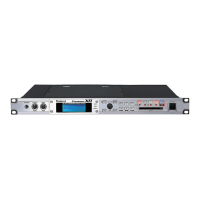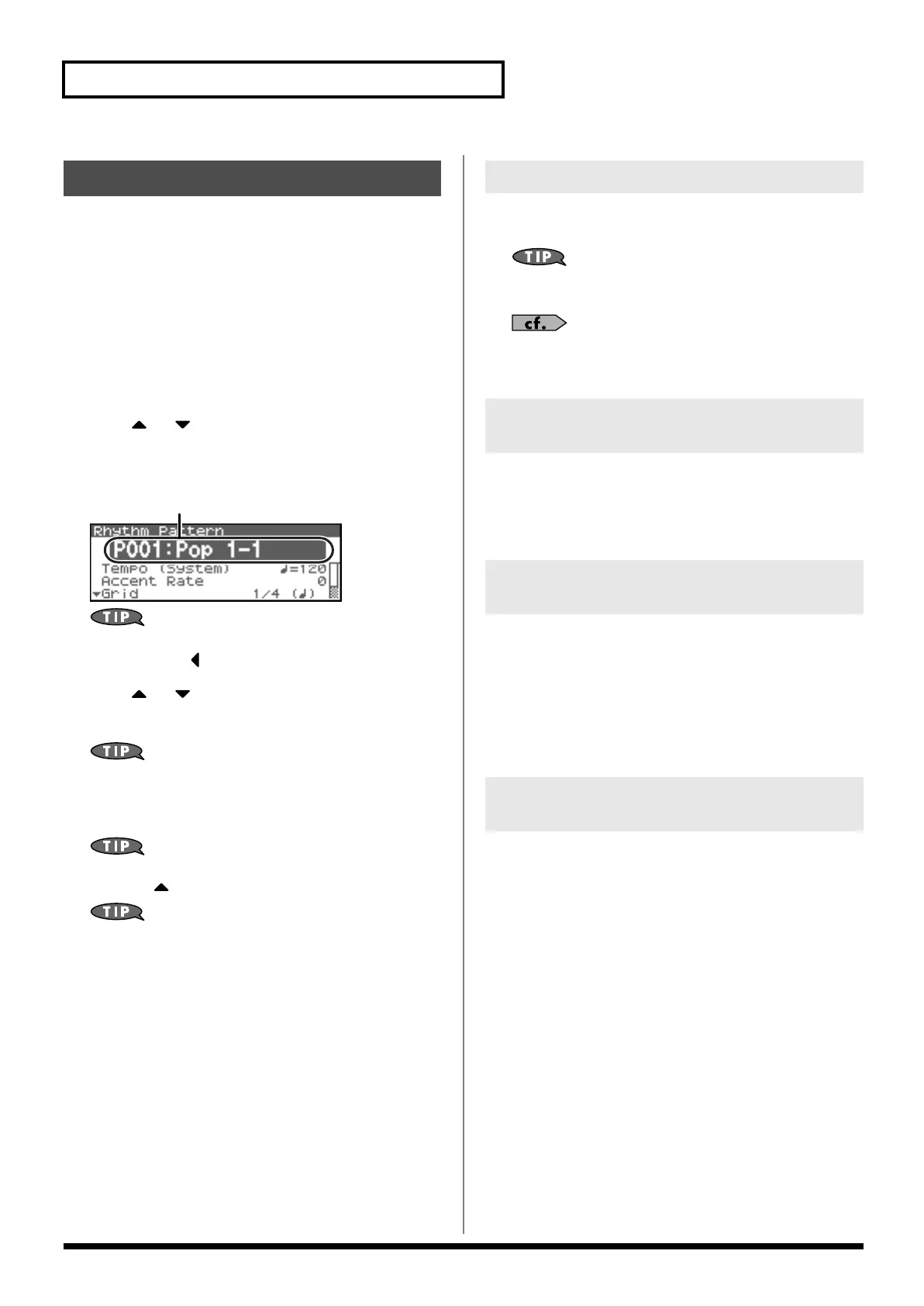110
Playing Rhythms
1.
Press [ARP].
If you’re in Patch mode
* In Patch mode, select a patch before you proceed.
The Arpeggio/Chord Switch screen will appear.
If you’re in Performance mode
The Arp/Chd/Rhy Switch screen will appear.
2.
Press [MENU].
The Rhythm Menu screen (in Performance mode, the Arp/
Chd/Rhy Menu screen) will appear.
3.
Press or to select “Rhythm Pattern.”
4.
Press [ENTER].
The Rhythm Pattern screen will appear.
fig.13-014.e
While this screen is displayed, you can press [SHIFT] so it
lights, then press to view a list of the Rhythm patterns.
5.
Press or to move the cursor to each parameter,
and turn the VALUE dial or use [INC][DEC] to make the
setting.
By pressing OUTPUT knob, you can audition the sound of the
rhythm pattern.
6.
When you have made the setting, press [EXIT].
In the Rhythm Pattern screen, you can press [SHIFT] so it lights,
then press to move the cursor to the rhythm pattern.
When you save a Performance, the Rhythm Pattern on/off
status, the Rhythm Group number, and the settings of the
Rhythm Pattern screen (p. 111) are also saved.
If you want to create a combination of sounds and rhythm
pattern settings, use Performance mode to create and store your
settings.
Select the basic playing style of the rhythm.
Value:
P001–256 (Preset), U001–256 (User)
You can press [GROUP] to switch between User and Preset
memories.
For more on the prepared Rhythm Patterns already
programmed in the Fantom-XR, refer to
“Rhythm Pattern List”
(p. 240).
This sets the Rhythm pattern tempo.
* Editing the Tempo setting will change the System setting “Tempo” (p.
156). The tempo setting cannot be saved in the Rhythm Group.
Value:
5–300
When you play rhythm patterns, the velocity of each note is
determined by the velocity of the notes programmed within the
arpeggio style. You can adjust the amount (“spread”) of this
dynamic variation. With a setting of 100%, the notes will have the
velocities that are programmed by the rhythm pattern. With a setting
of 0%, all notes will be sounded at a fixed velocity.
Value:
0–100%
This sets the particular note division and resolution in a “single
grid” used in creating the pattern in an Rhythm Pattern, and how
much of a “shuffle” syncopation is to be to applied (none/weak/
strong) to it (grid type).
* Grid settings are shared with the arpeggio. (p. 99)
Value:
1/4:
Quarter note (one grid section = one beat)
1/8:
Eighth note (two grid sections = one beat)
1/8L:
Eighth note shuffle Light (two grid sections = one beat,
with a light shuffle)
1/8H:
Eighth note shuffle Heavy (two grid sections = one beat,
with a heavy shuffle)
1/12:
Eighth note triplet (three grid sections = one beat)
1/16:
Sixteenth note (four grid sections = one beat)
1/16L:
Sixteenth note shuffle Light (four grid sections = one
beat, with a light shuffle)
1/16H:
Sixteenth note shuffle Heavy (four grid sections = one
beat, with a heavy shuffle)
1/24:
Sixteenth note triplet (six grid sections = one beat)
Rhythm Pattern Settings
Rhythm pattern
Selecting Rhythm Patterns
Determining the Tempo for Rhythm
Pattern (Tempo)
Changing the Accent Strength
(Rhythm Accent)
Changing the Beat and Shuffle
(Grid)
Fantom-XR_r_e.book 110 ページ 2006年4月4日 火曜日 午前10時14分

